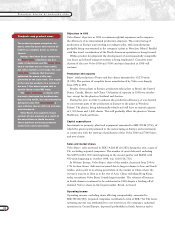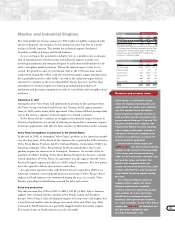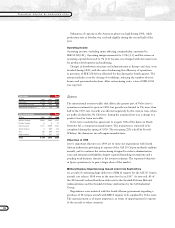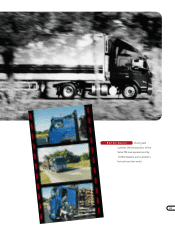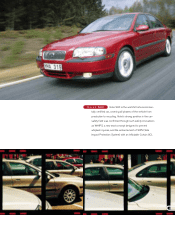Volvo 1998 Annual Report Download - page 42
Download and view the complete annual report
Please find page 42 of the 1998 Volvo annual report below. You can navigate through the pages in the report by either clicking on the pages listed below, or by using the keyword search tool below to find specific information within the annual report.
40
PERSONNEL
Personnel
Activities in 1998 were characterized to a great extent by product
renewal. Accordingly, major efforts were made in training and infor-
mation aimed at reducing lead-times and creating new and/or common
systems.
Where it once took up to six months to retool, changeover time was reduced to
eight weeks when production of the Volvo S80 in the Torslanda plant was being
planned.
To achieve this required well-planned training for the more than 3,000 assem-
blers who are now working on the Volvo S80, Volvo’s most technically advanced
car to date. The work was started about 2.5 years prior to production start with
the training of approximately 160 assemblers who participated in preproduction
of the Volvo S80. This was done in order to be able to affect product details and
the production process at an early stage, viewed from an assembly perspective,
and also to obtain detailed knowledge about the product. The task of each of the
assemblers was to be an instructor and spread knowledge in his or her area of
responsibility in the plant.
The aim was to give each assembler leading-edge expertise for his or her
specific job. This was most apparent in the electrical and electronic sector, since
the electronics in the Volvo S80 are much more advanced than in earlier models.
Training was carried out following a basic analysis of skills, after which the
assemblers’ knowledge was tested.
The Torslanda plant in Göteborg, Sweden met its objectives in terms of
quality, quantities and delivery precision. During 1998, 32,800 Volvo S80s were
produced, compared with the introduction of the Volvo 850 model in 1991
when 7,400 cars were produced.
With the new platform as a base, and with the experience gained from this
training program, the need for test-construction of cars is expected to decrease
and the time required for production retooling is expected to become shorter.
Prior to the introduction in 1998 of Volvo Trucks’ new heavy truck family
Volvo FM, similar training was carried out during the year.
Training and integration in connection with acquisitions
On May 7, 1998, Volvo Construction Equipment acquired Samsung Heavy
Industries’ construction equipment division in Changwon, South Korea, with
The Volvo Group’s ambition is to establish
work forms that increase productivity,
enhance quality and consequently
improve competitiveness and profitability.
Increased knowledge, process orientation,
less bureaucracy and greater assumption
of responsibility by employees are
cornerstones in the continuous process of
change which is necessary for sustainable
competitiveness.
Volvo’s work with operational develop-
ment has yielded favorable results since
the start with several pilot projects in
1996. Accordingly, the number of projects
has grown successively and an increasing
number of employees are involved in the
process. Evidence of the intensity of this
work was provided in 1998 when Volvo
Trucks won the Swedish Quality award,
with the following motivation:
“Operations are permeated by a strong
and clear vision to create value for the
customer. The foundation is committed
leadership, a well-structured strategic
planning process and good communica-
tions with customers, suppliers and
employees. A successive breakdown of
visions and goals creates involvement,
commitment and pride in the company’s
successes. In a large global organization,
the company has succeeded with a syste-
matic improvement process that success-
fully permeates most of its operations
Volvo Trucks is a fine example of quality
development in Sweden.”
All programs, which have been under
way for more than 12 months, have
contributed to significant improvements in
the form of increased productivity, higher
quality and shorter lead times. During
1998, several programs were started in
Volvo’s plants in Europe and the US.
Operational development




